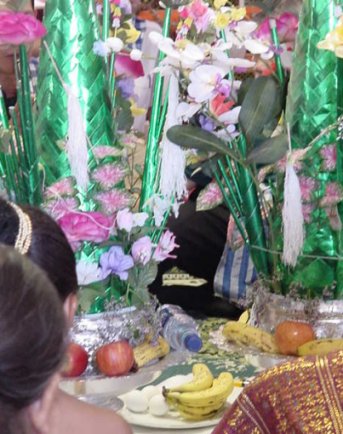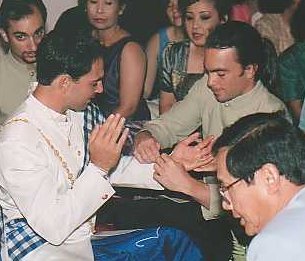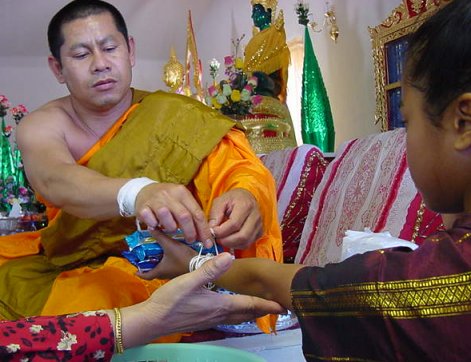 In the Buddhist tradition practiced in Laos, any and all special occassions are
marked by an event known as Baci (pronounced Bah See). Baci is staged for marriages,
graduations, convalescents, deaths, going-away, etc...
In the Buddhist tradition practiced in Laos, any and all special occassions are
marked by an event known as Baci (pronounced Bah See). Baci is staged for marriages,
graduations, convalescents, deaths, going-away, etc...
 In the Buddhist tradition practiced in Laos, any and all special occassions are
marked by an event known as Baci (pronounced Bah See). Baci is staged for marriages,
graduations, convalescents, deaths, going-away, etc...
In the Buddhist tradition practiced in Laos, any and all special occassions are
marked by an event known as Baci (pronounced Bah See). Baci is staged for marriages,
graduations, convalescents, deaths, going-away, etc...
The green centerpiece is called Mak Beng. The smaller green shoots surrounding the centerpiece are
Loog Mak Beng . Loog means 'offspring of'. Mak Beng is always presented on a
silver or gold platter. Mak Beng and the platter ensemble is called Pah Q'oun.
Pah means tray. Q'oun means spirits.

Mak Beng is traditionally made out of fresh banana leaves. In the U.S., an abundant of banana leaves is hard to come by, so it is typical to see the Mak Beng constructed out of silver, gold, or green paper. However, nothing beats the real thing. The Mak Beng made out of banana leaves exudes a sense antiquity and mystery that can not be matched by the fake Vegas-styled ones.
Sticks with white cotton strings and flowers are stabbed into the Mak Beng. At the top, candles and flowers are inserted in a tiny hole. When Mak Beng is positioned in a silver bowl (to become Pah Q'uon), uncooked rice is poured in the bowl to stabilize the center piece. Food items are place around the platter. Whiskey is a customary accompaniment.
 One of the many characteristics that Lao traditions inherited from the Hindu is that there
are spirits for every thing that exists. Each individual string hanging from the Pah Q'uon
represents a spirit. As a string is tied on a wrist, words welcoming good fortune or
warnings for the bad spirits are spoken. Food items are placed in the hand as the words are
spoken and the string is tied. The edible goods in the hand symbolize that anything the recepient
desires is within his reach. When the person tying the string completes his offer
of good fortune, the person receiving the string puts both his hands together in a prayer position
and says 'thank you'. The string being tied to a wrist signifies that the spirit is bound to
the recepient of the string. The spirit can not escape. Therefore, the recepient has
a 'guardian angel' protecting him. The process of string tying is called Poog Kan
One of the many characteristics that Lao traditions inherited from the Hindu is that there
are spirits for every thing that exists. Each individual string hanging from the Pah Q'uon
represents a spirit. As a string is tied on a wrist, words welcoming good fortune or
warnings for the bad spirits are spoken. Food items are placed in the hand as the words are
spoken and the string is tied. The edible goods in the hand symbolize that anything the recepient
desires is within his reach. When the person tying the string completes his offer
of good fortune, the person receiving the string puts both his hands together in a prayer position
and says 'thank you'. The string being tied to a wrist signifies that the spirit is bound to
the recepient of the string. The spirit can not escape. Therefore, the recepient has
a 'guardian angel' protecting him. The process of string tying is called Poog Kan
 The string can not be tied in just any old fashion. The string must be tied loosely so the
person can untie it after three days without using knives or scissors. The spirit must
be released gently. If the string is severed with a sharp object, then the spirit is not
released, but destroyed - a bad omen.
The string can not be tied in just any old fashion. The string must be tied loosely so the
person can untie it after three days without using knives or scissors. The spirit must
be released gently. If the string is severed with a sharp object, then the spirit is not
released, but destroyed - a bad omen.
| [Main Page] |
|
Copyright 2002 AZWATLAO.ORG, All Rights Reserved. Please do not use content without permission. |